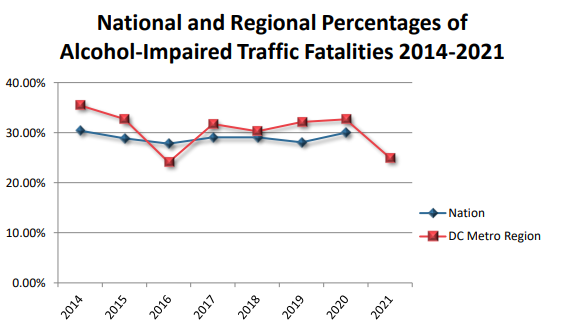Alcohol- and drug-involved traffic deaths in the D.C. region are lower than the national average, according to a new report.
Data from the How Safe Are Our Roads? report, prepared by the Metropolitan Washington Council of Governments (COG) for the nonprofit Washington Regional Alcohol Program (WRAP), also shows that traffic-related injuries, crashes and arrests between 2020 and 2021 are up in the area.
“It’s a mixed bag,” said Kurt Gregory Erickson, the president and CEO of WRAP.

“While nationally, drunk driving fatalities are on the rise, that’s not the case in the greater Washington area,” he said. “These type of 100% preventable fatalities actually dropped, and they dropped significantly, by 10%,” he said.
That decrease, Erickson said, reflects the lowest recorded numbers in a half-decade, while early estimates from the National Highway Traffic Safety Administration show a nationwide increase of 5% in fatalities in police-reported, alcohol-involved crashes.
In this area, “Fatalities are down — the crashes, injuries and arrests, up,” Erickson said of the report, which shows a 17% increase in local alcohol and/or drug-related traffic injuries and a 13% increase in the number of alcohol and/or drug-related crashes.

Even though fewer resources are available for enforcement — the Virginia Association of Chiefs of Police estimates that staffing at law enforcement agencies, at least in the Commonwealth, is down anywhere between 15% and 25% — local arrests for either driving under the influence or driving while impaired increased by what Erickson called a statistically significant 3.7% between 2020 and 2021.
“Trust me: Nobody’s waving a victory flag here, when we’re still arresting over 10,000 persons annually — roughly 28 a day — just in the Greater Washington area. It really proves that we have still got a lot of work to do,” he said.
“Whereas that’s a daunting number — it’s also a number worthy of acclaim, of thanking the men and women that are actually doing this, that are single-handedly removing would-be drunk drivers off of our shared roadways,” Erickson said of WRAP’s 25th anniversary Law Enforcement Awards ceremony, which will be held next week.
In the forum provided by COG, localities comparing results from various strategies can pivot toward programs shown to work.
“Looking at the individual county or city level, you can see some pretty big variances,” Erickson said.
Loudoun County, Virginia, went from seven drunk and drugged driving deaths in 2020 to two in 2021. Nearby Prince William County went from three to 10, Erickson said.
In Montgomery County, Maryland, the number of drunk and drugged driving injuries decreased by a little more than 6%. In neighboring Prince George’s County, those injuries increased by nearly 30%, going from 277 such injuries in 2020 to 358 last year.
“That’s where we’re going to have to really try to focus in on what’s happening at the local level. For those things that are going well, how can they be replicated? And for those things that aren’t going well, how can we improve those numbers?” Erickson said.
“This report really drills down. I would encourage anybody to look at it online, that can look at individual localities, and to try to make the connection — whether these are tied in any way to any kind of prevention efforts there were increased, deterrent efforts in terms of law enforcement, or whatever else was accomplished or attempted to try to bring these numbers downward.”
Erickson said the single best way people on the road can protect themselves from impaired drivers is to wear seatbelts.








